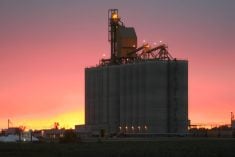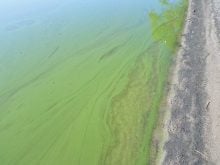As cattle head out to pasture for another season, producers in Western Canada need to be watchful for poisonous plants. There are as many as 200 species of plants implicated in poisonings in Alberta alone. It always pays to be alert when checking pastures; new weeds or plants should always be identified. Some have nutritional value others are strict competitors to existing pasture and yet others are poisonous. Fortunately most poisonous plants would not be the first choice for cattle if adequate grass is available. If baled or silaged, however, the percentage of harmful plants in the feed could get too high and deleterious signs might result.
Read Also

Cancer agency reclassifies another herbicide ‘probably carcinogenic’
The WHO’s cancer research agency has now put atrazine, a herbicide well known to corn growers, in the same potential-hazard category where the agency put glyphosate.
Different areas of Western Canada have poisonous plants common to a geographic region. It is very important to familiarize yourself with the poisonous plants specific to your area. As with anything in animal health, prevention is far better than the cure. Overgrazing, droughts and moving or trailing cattle when hungry all contribute to increasing the likelihood of poisonings if toxic plants or weeds are present. Cattle lacking minerals or salt may crave strange things. If you know you have poisonous weeds present try to graze the area when their growth stage is less toxic. With plants like tall larkspur, monkshood or water hemlock physically removing the plants can be practised if they are not too widespread. The effort will be well worth it to prevent future cattle or other species deaths.
Treatment for most poisonings does not lead to much success partially because sudden death is often the presenting complaint. Most attack the central nervous system (CNS) and other than controlling the convulsions and other CNS signs cattle must detoxify the poison on their own. Many other common weeds such as tansy can cause liver damage over time. Since there is insidious damage by the time clinical signs of liver failure are seen the disease has progressed too far to be reversed.
The most dreaded plant is water hemlock because so very little of the poison (primarily contained in the root bulb) is needed to cause death. Consumption of one root will kill a cow. It is found near a water source such as around dugouts or on stream banks. In our area it is often confused with either the cow parsnip or water parsnip. The much more common cow parsnip (with very large leaves) actually has fairly good grazing value.
Drought conditions when cattle graze more low land where less palatable grasses are is when poisonings occur. Likewise in real wet conditions cattle are more apt to pull the plant right out and consume the bulb. Fortunately I have never had a case of water hemlock poisoning. In our area sightings are rare yet there are pockets here and there. This is why when pasturing cattle great distances from home find out if there are any local poisonous plants. You may be surprised what you will find out from talking to the locals. This applies to all animal diseases. Certain areas throughout Western Canada have their own unique disease prevalence’s.
Another common poisoning occurs from tall larkspur, especially in the south in Alberta towards the foothills and over into the BC interior. This plant grows tall and has a distinct bluish to purple flower. The consumption of as little as 0.7 per cent of young plants is toxic. A lot of people use larkspur also called Delphinium in ornamental flower gardens. The tame varieties are supposedly not as toxic, but I personally can’t tell the difference by looking at them. Watch for any carryover from nearby acreages or cattle getting loose into flower gardens. Not only will the acreage owner be angry at you, but poisoned cattle could result.
Another common ornamental, which is poisonous, is monkshood. For identification of these poisonous plants and other noxious weeds there are several good publications put out by the federal or provincial governments. Also several good websites both in Canada and the US by the departments of agriculture outline signs and geographic distribution as well as pictorial representations. Try the Alberta site www.agric.gov.ab.ca.or the publication “Poisonous Plants of Western Canada” an Agriculture Canada publication.
A lot of the more common weeds can cause problems if grazed or fed to excess. This may be with baled hay on a newly seeded field where volunteer weeds have come up. Intensive rotational grazing has many good points however one high risk practice is when cattle are left in an area too long and are forced to graze less palatable plants which have toxic effects.
There have been reported poisonings with stinkweed, lambs quarter and tansy ragwort. These plants are less palatable fortunately but in confined grazing situations or in prepared feeds high levels can lead to death. Tansy has also been incriminated as an abortifacient (a substance that induces abortion), but I have not seen any strong evidence to this effect. However if pregnant cattle get really sick from any condition, aborting is a self defence mechanism. In order to survive the fetus may be the first to go, another loss as producers we want to avoid Other poisonous plants in Western Canada that may be in your area are arrow-grass, death camus, timber milk vetch, narrow-leaved milk vetch, silky lupine, bracken fern, horsetail, and choke cherries.
Another very poisonous plant if it classified as such is blue green algae. This requires very specific conditions of growth and wind conditions concentrating the toxin in the water supply. This has become very rare especially with the advent of remote wind solar or other watering systems. The water is drawn from well below the surface where the algae are really not as prevalent.
Always be cognisant of the possibility of plant poisonings and report any sudden deaths or nervous conditions to your veterinarian. Avoid the grazing pitfalls described which can lead to these poisonings and hopefully you will never experience them on your farm.
Roy Lewis is a practising Large Animal Veterinarian at the Westlock Veterinary Center, north of Edmonton, AB. His main interests are bovine reproduction and herd health.














